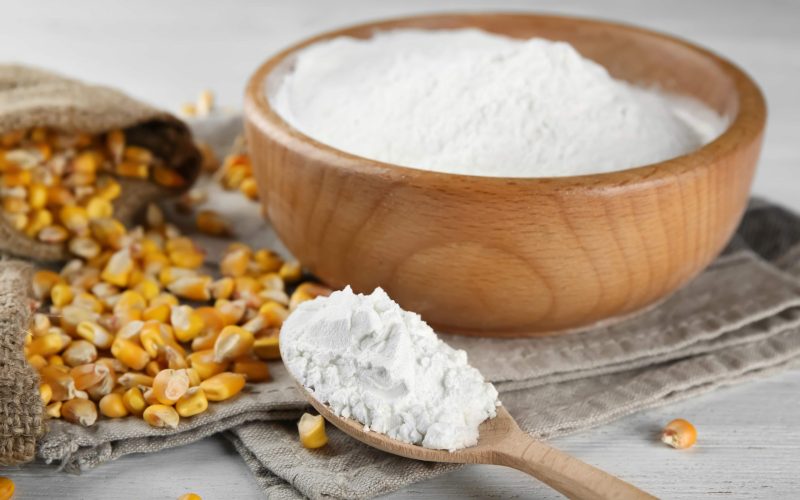If you’re looking for the best Substitutes for cornstarch for thickening sauces, gravies, and puddings, you’ve come to the right place.
Cornstarch is a joint thickening agent used in many recipes, but it’s not the only one out there.
In our blog post, we’ll explore the best substitutes for cornstarch that you can use as a thickener.
Whether you’re looking for a gluten-free alternative or want to try something new, these substitutes will add flavor and texture to your dishes.
1. Wheat Flour
Wheat flour is first on our list of Substitutes for cornstarch. It is an excellent substitute for cornstarch and a great choice for thickening sauces, gravies, and soups.
Wheat flour has the same thickening capabilities as cornstarch but has a different flavor profile and texture than cornstarch.
To use wheat flour as a thickening agent, you will need to make a slurry by combining equal parts of wheat flour and cold water in a bowl and mixing them until they are smooth.
This slurry should be added to your recipe gradually, stirring constantly until the desired thickness is reached.
One important thing to note is that using wheat flour as Substitutes for cornstarch can cause the sauce or gravy to be darker than normal.
If you don’t want to darken your sauce or gravy, use arrowroot powder or tapioca flour instead.
Wheat flour can also thicken other dishes, such as casseroles, stir-fries, and stews. It’s an easy-to-use, convenient substitute for cornstarch that can be found in almost any grocery store.
2. Arrowroot
Arrowroot is also on our list of Substitutes for cornstarch. It is a starchy flour derived from the rhizomes of several tropical plants, including Maranta arundinacea and Manihot esculenta.
It is a common ingredient used as a thickener in food preparations and has been used as Substitutes for cornstarch for many years.
Arrowroot is an excellent thickening agent and can be used in many recipes instead of cornstarch.
It can be used like cornstarch but works faster and at lower temperatures. It is also often used as a vegan alternative to other thickeners that contain animal products such as gelatin.
Arrowroot has a neutral flavor and does not affect the dish’s taste when added. It also has a glossy finish, giving sauces and gravies an attractive sheen.
Arrowroot is easy to find in most grocery and health food stores, although it may be labeled differently depending on where you purchase it.
To use arrowroot as Substitutes for cornstarch, replace one tablespoon of cornstarch with two tablespoons of arrowroot.
Arrowroot should be added to liquids before they are heated to prevent clumping.
When using arrowroot as a thickening agent, simmer the mixture for about 10 minutes to allow the starch to activate entirely.
3. Potato Starch
Potato starch is an excellent substitute for cornstarch as it can help thicken sauces and stews, just like cornstarch.
Potato starch is made from the starch extracted from potatoes and is gluten-free, making it a popular choice for those with allergies or who are on special diets.
While potato starch has more thickening power than cornstarch, it should be used sparingly as it can easily make a dish too thick.
To use potato starch, combine it with cold water before adding it to hot dishes, as it works best when added at the end of cooking.
It can also be used to create smooth gravies and creamy sauces.
4. Tapioca
Tapioca is a starchy, sweet ingredient made from the crushed root of the cassava plant. It is often used in baking and as a thickening agent, making it an ideal substitute for cornstarch.
Tapioca has thickening properties similar to cornstarch, but it needs to be cooked longer to achieve the same consistency.
It also has a slightly sweeter taste, making it an excellent choice for dishes that call for a sweet flavor.
To use tapioca as a substitute for cornstarch, cook twice as much as cornstarch for 10 minutes.
This will ensure that your dish comes out just as thick and creamy as it would with cornstarch.
5. Rice Flour
Rice flour is one of the most commonly used substitutes for cornstarch. It is often a thickener in sauces, soups, and stews.
Rice flour has a neutral taste and does not affect the color or flavor of dishes. It can also thicken pies, custards, and other desserts.
Rice flour is not as powerful a thickener as cornstarch, so it may need to be used in larger amounts.
It is also important to remember that rice flour needs to be mixed with a liquid before adding it to recipes.
This will ensure that it dissolves completely and provides maximum thickening power.
When using rice flour as a substitute for cornstarch, it is essential to note that the amount of rice flour should be twice that of cornstarch.
This is because rice flour is not as powerful a thickener as cornstarch.
Additionally, rice flour should be cooked at a lower temperature than cornstarch since it can burn quickly.
If rice flour is overcooked, it can become lumpy, so it is important to keep an eye on it when cooking.
6. Glucomannan
Glucomannan is a soluble dietary fiber derived from the konjac plant.
It’s often used as Substitutes for cornstarch as it thickens and adds body to sauces and gravies, making it an excellent substitute for anyone avoiding corn-based products.
Glucomannan works best when hot liquids are added, forming a gel-like consistency.
It also has the added benefit of providing additional health benefits, such as helping to regulate blood sugar levels and improve digestive health.
When substituting glucomannan for cornstarch, you will need to use more of it to achieve the desired thickness, as it is not as potent as cornstarch.
To use glucomannan as a thickener for sauces or gravies, mix glucomannan with cold liquid until it is completely dissolved before adding it to your hot recipe.
Make sure to stir constantly while adding glucomannan to ensure it is adequately distributed throughout the dish.
7. Psyllium Husk
Psyllium husk is next on our list of Substitutes for cornstarch. It is a form of soluble fiber that has many beneficial properties for the digestive system.
It can also be used as a substitute for cornstarch when baking and cooking.
Psyllium husk Substitutes for cornstarch absorb moisture, creating a thicker consistency than cornstarch. It is suitable for vegans and gluten-free and is a great dietary fiber source.
When using psyllium husk as a substitute for cornstarch, use psyllium husk with every 2 tablespoons of cornstarch.
This will give you a thick and creamy texture, similar to what you would get when using cornstarch.
Combine the psyllium husk with cold liquid before adding it to the recipe for best results.
8. Xanthan Gum
Xanthan gum is a polysaccharide derived from the fermentation of glucose, sucrose, or lactose.
It’s known for its excellent thickening properties and can act as an excellent Substitutes for cornstarch.
When substituting xanthan gum for cornstarch, use only half the amount of the original recipe’s cornstarch.
For example, if your recipe calls for one tablespoon of cornstarch, use only half a tablespoon of xanthan gum.
It is also important to note that when using xanthan gum as a substitute for cornstarch, it must be combined with cold liquid and then heated until it has been fully incorporated into the mixture.
Xanthan gum Substitutes for cornstarch have many other applications in cooking and baking, as they can also provide elasticity, hold ingredients together, and act as emulsifiers.
Additionally, it is often used to provide texture and volume to baked goods such as cakes and cookies.
Xanthan gum is gluten-free, so it’s an excellent option for gluten intolerant people.
Despite its positive qualities, some people may experience digestive discomfort when consuming large amounts of xanthan gum, so keep that in mind when using it as Substitutes for cornstarch.
9. Guar Gum
Lastly, Guar gum is a natural, gluten-free powder made from the seed of the guar plant. It has eight times the thickening power of cornstarch and can be used as a substitute.
Because it has no flavor, guar gum does not change the flavor of the food in which it is used.
Additionally, because it has no calories and few carbohydrates, guar gum makes an excellent choice for those watching their diet or calorie intake.
To use it as a substitute for cornstarch, mix one-part guar gum with one part cold water until dissolved. Then add the mixture to hot liquids and constantly stir until thickened.
When using guar gum as Substitutes for cornstarch, it is essential to note that it needs to be used in smaller amounts as it is much more powerful.
It is also essential to always remember to add guar gum to a cold liquid first and then add the mixture to a hot liquid, as adding guar gum directly to hot liquids will cause it to clump up.
Guar gum can be found in most health food stores or online retailers.
Conclusion
Are you looking for Substitutes for cornstarch? Whether it’s due to dietary restrictions or simply a desire to experiment with different ingredients, knowing what other options are available can be helpful.
In our blog post, we have explored the best substitutes for cornstarch and how they can be used in various recipes.
We hope you’ve read to learn more about these great Substitutes for cornstarch! Enjoy!








